Empirical Energy Consumption Estimation and Battery Operation Analysis from Long-Term Monitoring of an Urban Electric Bus Fleet
Abstract
1. Introduction
1.1. Energy Consumption Estimation of BEBs
1.2. Battery-Friendly Operation
- Operate at low Depth of Discharge (DoD) cycles centered at about 50% SOC or lower with frequent charging;
- Operate at near room temperature and store at a low temperature;
- Keep the battery at a low SOC level when storing for longer periods of time (e.g., 30%);
- Avoid high SOC states (typically, degradation is highest at 100% SOC due to higher cell voltage);
- Charge at low power using C-rates below 2 C, where the C-rate refers to the rate at which a battery is charged or discharged relative to its capacity (e.g., 1 C means a full charge or discharge in one hour).
1.3. Research Contribution of This Study
2. Methods
2.1. Overview over Bus Fleet and Signal Set
2.2. Energy Consumption Analysis
2.3. Usage Analysis on SOC Levels and Charging Power
3. Results
3.1. Analysis of the Specific Energy Consumption
3.2. Analysis of Battery Operation
3.3. Estimation of the Impact of Operational Recommendations on Battery Lifetime
3.4. Environmental Impact
4. Discussion
Author Contributions
Funding
Data Availability Statement
Acknowledgments
Conflicts of Interest
Abbreviations
| OEM | Original Equipment Manufacturer |
| EU | European Union |
| BEB | Battery-Electric Bus |
| SOC | State of Charge |
| SEC | Specific Energy Consumption |
| SOH | State of Health |
| DoD | Depth of Discharge |
| TCO | Total Cost of Ownership |
| EOL | End of Life |
| CSRD | Corporate Sustainability Reporting Directive |
References
- ACEA. New Commercial Vehicle Registrations: Vans +8.3%, Trucks −6.3%, Buses +9.2% in 2024. 2025. Available online: https://www.acea.auto/cv-registrations/new-commercial-vehicle-registrations-vans-8-3-trucks-6-3-buses-9-2-in-2024/ (accessed on 24 July 2025).
- European Commission. Communication from the Commission to the European Parliament, the Counsil, the European Econimic and Social Committee and the Committee of the Regions; Technical Report COM/2020/562 Final; European Commission: Brussels, Belgium, 2020. [Google Scholar]
- Grauers, A.; Borén, S.; Enerbäck, O. Total cost of ownership model and significant cost parameters for the design of electric bus systems. Energies 2020, 13, 3262. [Google Scholar] [CrossRef]
- Kim, H.; Hartmann, N. Total Cost of Ownership Analysis of Battery Electric Buses for Public Transport System in a Small to Midsize City; International Association for Energy Economics: Cleveland, OH, USA, 2022. [Google Scholar]
- Xiao, G.; Xiao, Y.; Shu, Y.; Ni, A.; Jiang, Z. Technical and economic analysis of battery electric buses with different charging rates. Transp. Res. Part Transp. Environ. 2024, 132, 104254. [Google Scholar] [CrossRef]
- Jefferies, D.; Göhlich, D. A comprehensive TCO evaluation method for electric bus systems based on discrete-event simulation including bus scheduling and charging infrastructure optimisation. World Electr. Veh. J. 2020, 11, 56. [Google Scholar] [CrossRef]
- Paul, T.; Yamada, H. Operation and charging scheduling of electric buses in a city bus route network. In Proceedings of the 17th International IEEE Conference on Intelligent Transportation Systems (ITSC), Qingdao, China, 8–11 October 2014; pp. 2780–2786. [Google Scholar] [CrossRef]
- Xylia, M.; Leduc, S.; Patrizio, P.; Kraxner, F.; Silveira, S. Locating charging infrastructure for electric buses in Stockholm. Transp. Res. Part Emerg. Technol. 2017, 78, 183–200. [Google Scholar] [CrossRef]
- Al-Ogaili, A.S.; Al-Shetwi, A.Q.; Al-Masri, H.M.; Babu, T.S.; Hoon, Y.; Alzaareer, K.; Babu, N.P. Review of the estimation methods of energy consumption for battery electric buses. Energies 2021, 14, 7578. [Google Scholar] [CrossRef]
- Ji, J.; Bie, Y.; Zeng, Z.; Wang, L. Trip energy consumption estimation for electric buses. Commun. Transp. Res. 2022, 2, 100069. [Google Scholar] [CrossRef]
- Gallet, M.; Massier, T.; Hamacher, T. Estimation of the energy demand of electric buses based on real-world data for large-scale public transport networks. Appl. Energy 2018, 230, 344–356. [Google Scholar] [CrossRef]
- Abdelaty, H.; Mohamed, M. A prediction model for battery electric bus energy consumption in transit. Energies 2021, 14, 2824. [Google Scholar] [CrossRef]
- Pihlatie, M.; Pippuri-Mäkeläinen, J. (Eds.) Electric Commercial Vehicles (ECV): Final Report; Number 348 in VTT Technology; VTT Technical Research Centre of Finland: Espoo, Finland, 2019. [Google Scholar] [CrossRef]
- Fraunhofer IVI. Simulation Tool IVIsion. 2025. Available online: https://www.ivi.fraunhofer.de/en/research-fields/vehicle-and-propulsion-technologies/propulsion-technologies/simulation-tool-ivision.html (accessed on 4 July 2025).
- Pamuła, T.; Pamuła, W. Estimation of the Energy Consumption of Battery Electric Buses for Public Transport Networks Using Real-World Data and Deep Learning. Energies 2020, 13, 2340. [Google Scholar] [CrossRef]
- Xing, Y.; Li, Y.; Liu, W.; Li, W.; Meng, L. Operation Energy Consumption Estimation Method of Electric Bus Based on CNN Time Series Prediction. Math. Probl. Eng. 2022, 2022, 6904387. [Google Scholar] [CrossRef]
- Jalkanen, K.; Karppinen, J.; Skogström, L.; Laurila, T.; Nisula, M.; Vuorilehto, K. Cycle aging of commercial NMC/graphite pouch cells at different temperatures. Appl. Energy 2015, 154, 160–172. [Google Scholar] [CrossRef]
- Plattard, T.; Barnel, N.; Assaud, L.; Franger, S.; Duffault, J.M. Combining a Fatigue Model and an Incremental Capacity Analysis on a Commercial NMC/Graphite Cell under Constant Current Cycling with and without Calendar Aging. Batteries 2019, 5, 36. [Google Scholar] [CrossRef]
- Han, X.; Lu, L.; Zheng, Y.; Feng, X.; Li, Z.; Li, J.; Ouyang, M. A review on the key issues of the lithium ion battery degradation among the whole life cycle. eTransportation 2019, 1, 100005. [Google Scholar] [CrossRef]
- Edge, J.S.; O’Kane, S.; Prosser, R.; Kirkaldy, N.D.; Patel, A.N.; Hales, A.; Ghosh, A.; Ai, W.; Chen, J.; Yang, J.; et al. Lithium ion battery degradation: What you need to know. Phys. Chem. Chem. Phys. 2021, 23, 8200–8221. [Google Scholar] [CrossRef] [PubMed]
- Xu, B.; Oudalov, A.; Ulbig, A.; Andersson, G.; Kirschen, D.S. Modeling of lithium-ion battery degradation for cell life assessment. IEEE Trans. Smart Grid 2016, 9, 1131–1140. [Google Scholar] [CrossRef]
- Ecker, M.; Gerschler, J.B.; Vogel, J.; Käbitz, S.; Hust, F.; Dechent, P.; Sauer, D.U. Development of a lifetime prediction model for lithium-ion batteries based on extended accelerated aging test data. J. Power Sources 2012, 215, 248–257. [Google Scholar] [CrossRef]
- Rumberg, B.; Schwarzkopf, K.; Epding, B.; Stradtmann, I.; Kwade, A. Understanding the different aging trends of usable capacity and mobile Li capacity in Li-ion cells. J. Energy Storage 2019, 22, 336–344. [Google Scholar] [CrossRef]
- Rumberg, B.; Epding, B.; Stradtmann, I.; Schleder, M.; Kwade, A. Holistic calendar aging model parametrization concept for lifetime prediction of graphite/NMC lithium-ion cells. J. Energy Storage 2020, 30, 101510. [Google Scholar] [CrossRef]
- Keil, P.; Schuster, S.F.; Wilhelm, J.; Travi, J.; Hauser, A.; Karl, R.C.; Jossen, A. Calendar aging of lithium-ion batteries. J. Electrochem. Soc. 2016, 163, A1872. [Google Scholar] [CrossRef]
- Baghdadi, I.; Briat, O.; Delétage, J.Y.; Gyan, P.; Vinassa, J.M. Lithium battery aging model based on Dakin’s degradation approach. J. Power Sources 2016, 325, 273–285. [Google Scholar] [CrossRef]
- Torregrosa, A.J.; Broatch, A.; Olmeda, P.; Agizza, L. A semi-empirical model of the calendar ageing of lithium-ion batteries aimed at automotive and deep-space applications. J. Energy Storage 2024, 80, 110388. [Google Scholar] [CrossRef]
- Gao, Y.; Jiang, J.; Zhang, C.; Zhang, W.; Jiang, Y. Aging mechanisms under different state-of-charge ranges and the multi-indicators system of state-of-health for lithium-ion battery with Li (NiMnCo) O2 cathode. J. Power Sources 2018, 400, 641–651. [Google Scholar] [CrossRef]
- Preger, Y.; Barkholtz, H.M.; Fresquez, A.; Campbell, D.L.; Juba, B.W.; Romàn-Kustas, J.; Ferreira, S.R.; Chalamala, B. Degradation of commercial lithium-ion cells as a function of chemistry and cycling conditions. J. Electrochem. Soc. 2020, 167, 120532. [Google Scholar] [CrossRef]
- de Hoog, J.; Timmermans, J.M.; Ioan-Stroe, D.; Swierczynski, M.; Jaguemont, J.; Goutam, S.; Omar, N.; Van Mierlo, J.; Van Den Bossche, P. Combined cycling and calendar capacity fade modeling of a Nickel-Manganese-Cobalt Oxide Cell with real-life profile validation. Appl. Energy 2017, 200, 47–61. [Google Scholar] [CrossRef]
- Gao, Z.; Xie, H.; Yang, X.; Niu, W.; Li, S.; Chen, S. The Dilemma of C-Rate and Cycle Life for Lithium-Ion Batteries under Low Temperature Fast Charging. Batteries 2022, 8, 234. [Google Scholar] [CrossRef]
- Kim, D.H.; Lee, J.; Shin, K.; Kim, K.B.; Chung, K.Y. Empirical Capacity Degradation Model for a Lithium-Ion Battery Based on Various C-Rate Charging Conditions. J. Electrochem. Sci. Technol. 2024, 15, 414–420. [Google Scholar] [CrossRef]
- Schreiber, M.; Gamra, K.A.; Bilfinger, P.; Teichert, O.; Schneider, J.; Kröger, T.; Wassiliadis, N.; Ank, M.; Rogge, M.; Schöberl, J.; et al. Understanding lithium-ion battery degradation in vehicle applications: Insights from realistic and accelerated aging tests using Volkswagen ID.3 pouch cells. J. Energy Storage 2025, 112, 115357. [Google Scholar] [CrossRef]
- Vermeer, W.; Chandra Mouli, G.R.; Bauer, P. A Comprehensive Review on the Characteristics and Modeling of Lithium-Ion Battery Aging. IEEE Trans. Transp. Electrif. 2022, 8, 2205–2232. [Google Scholar] [CrossRef]
- Leijon, J. Charging strategies and battery ageing for electric vehicles: A review. Energy Strategy Rev. 2025, 57, 101641. [Google Scholar] [CrossRef]
- Fraunhofer IVI. Remote Battery Diagnosis. 2025. Available online: https://www.ivi.fraunhofer.de/en/research-fields/electromobility/remote-battery-diagnosis.html (accessed on 4 July 2025).
- Zippenfenig, P. Open-Meteo.com Weather API; Zenodo: Geneva, Switzerland, 2023. [Google Scholar] [CrossRef]
- Weiss, M.; Cloos, K.C.; Helmers, E. Energy efficiency trade-offs in small to large electric vehicles. Environ. Sci. Eur. 2020, 32, 46. [Google Scholar] [CrossRef]
- Al-Wreikat, Y.; Serrano, C.; Sodré, J.R. Driving behaviour and trip condition effects on the energy consumption of an electric vehicle under real-world driving. Appl. Energy 2021, 297, 117096. [Google Scholar] [CrossRef]
- Lehmann, T.; Berendes, E.; Kratzing, R.; Sethia, G. Learning the Ageing Behaviour of Lithium-Ion Batteries Using Electric Vehicle Fleet Analysis. Batteries 2024, 10, 432. [Google Scholar] [CrossRef]
- Icha, P.; Lauf, D.T. Entwicklung der Spezifischen Treibhausgas-Emissionen des Deutschen Strommix in den Jahren 1990–2023; Technical Report CLIMATE CHANGE 23/2024; Umweltbundesamt: Dessau-Roßlau, Germany, 2024; ISSN 1862-4359. [Google Scholar]
- Özener, O.; Özkan, M. Fuel consumption and emission evaluation of a rapid bus transport system at different operating conditions. Fuel 2020, 265, 117016. [Google Scholar] [CrossRef]
- Zhang, S.; Wu, Y.; Liu, H.; Huang, R.; Yang, L.; Li, Z.; Fu, L.; Hao, J. Real-world fuel consumption and CO2 emissions of urban public buses in Beijing. Appl. Energy 2014, 113, 1645–1655. [Google Scholar] [CrossRef]
- European Parliament and Council of the European Union. Directive (EU) 2022/2464 of the European Parliament and of the Council of 14 December 2022 amending Regulation (EU) No 537/2014, Directive 2004/109/EC, Directive 2006/43/EC and Directive 2013/34/EU, as regards corporate sustainability reporting. Off. J. Eur. Union 2022, L322, 15–80. [Google Scholar]
- Liu, J.; Feng, L.; Li, Z. The Optimal Road Grade Design for Minimizing Ground Vehicle Energy Consumption. Energies 2017, 10, 700. [Google Scholar] [CrossRef]
- Lehmann, T.; Weiß, F. Lithium-Ion Battery Aging Analysis of an Electric Vehicle Fleet Using a Tailored Neural Network Structure. Appl. Sci. 2023, 13, 4448. [Google Scholar] [CrossRef]
- EDGAR (Emissions Database for Global Atmospheric Research). GHG Emissions of All World Countries: 2024 Report; Joint Research Centre, Publications Office of the European Union: Luxembourg, 2024; Available online: https://edgar.jrc.ec.europa.eu/report_2024 (accessed on 4 July 2025).
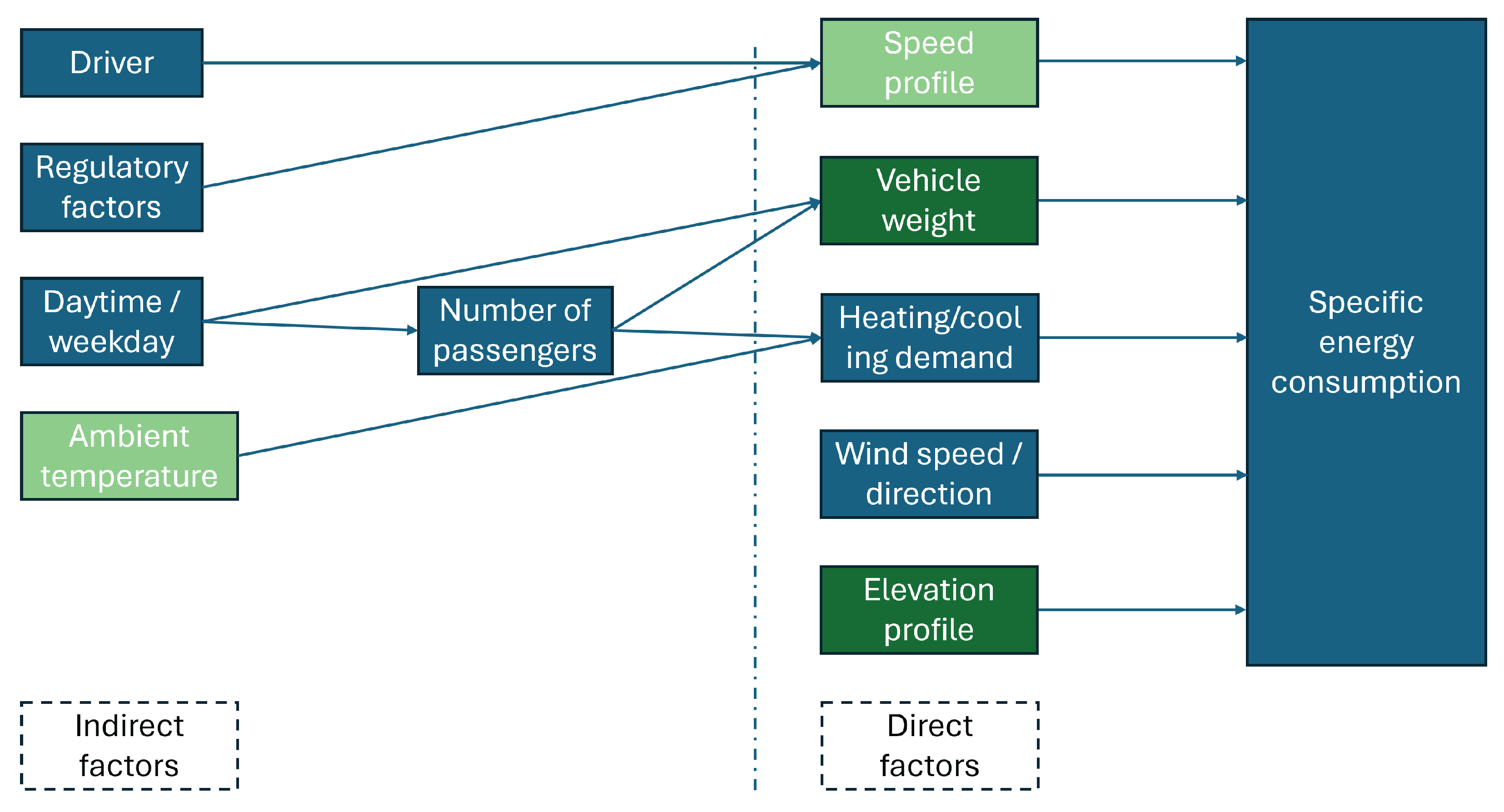

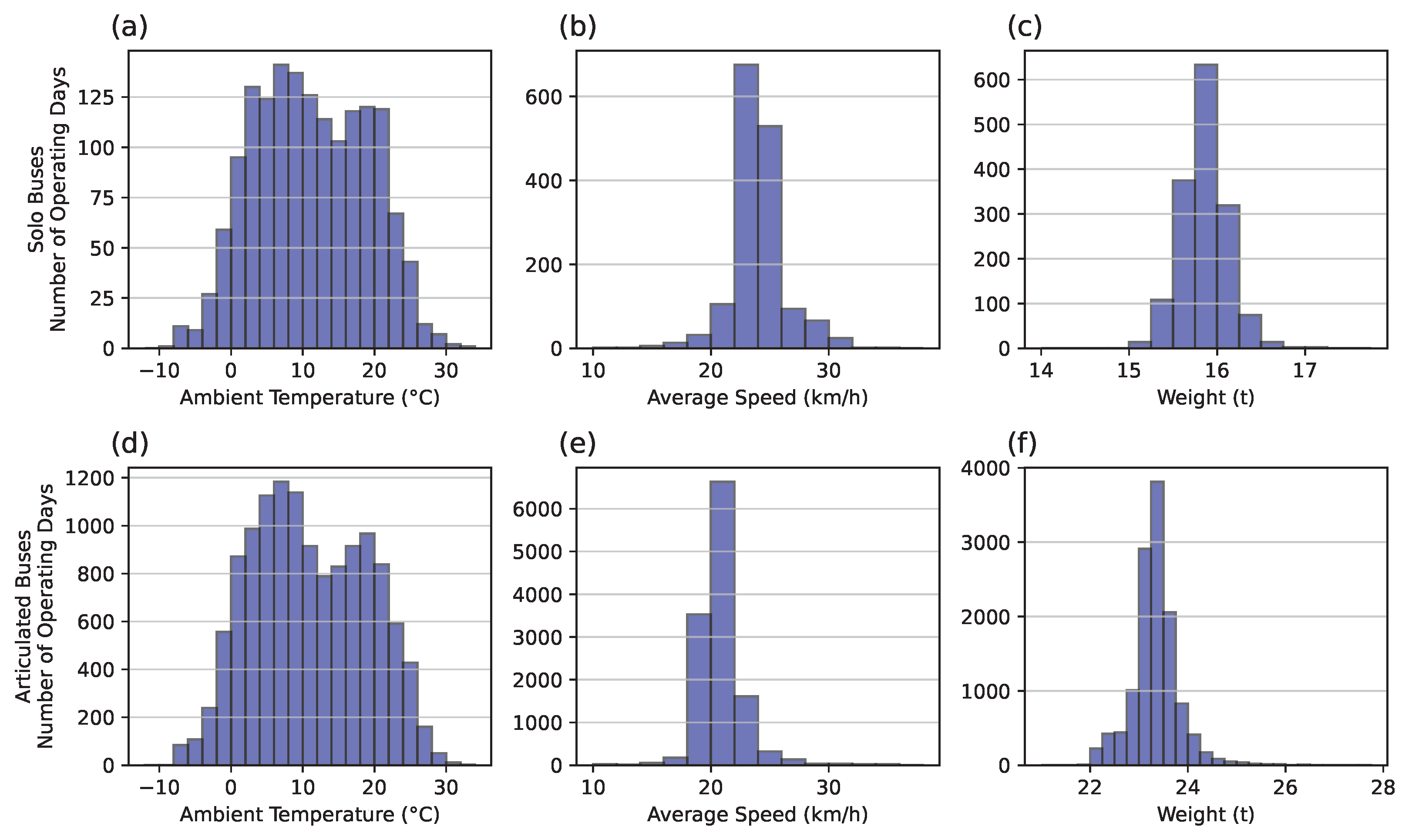
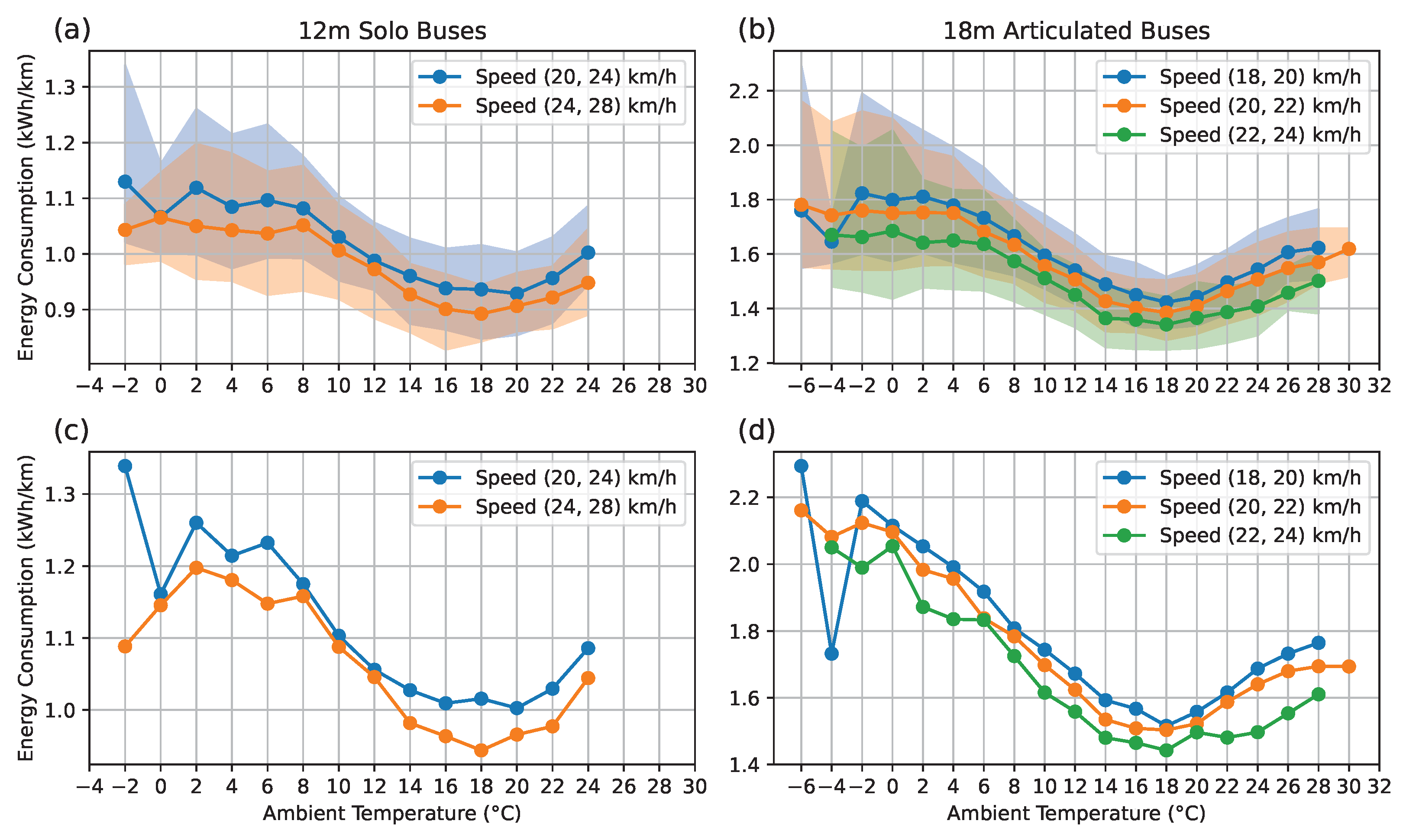
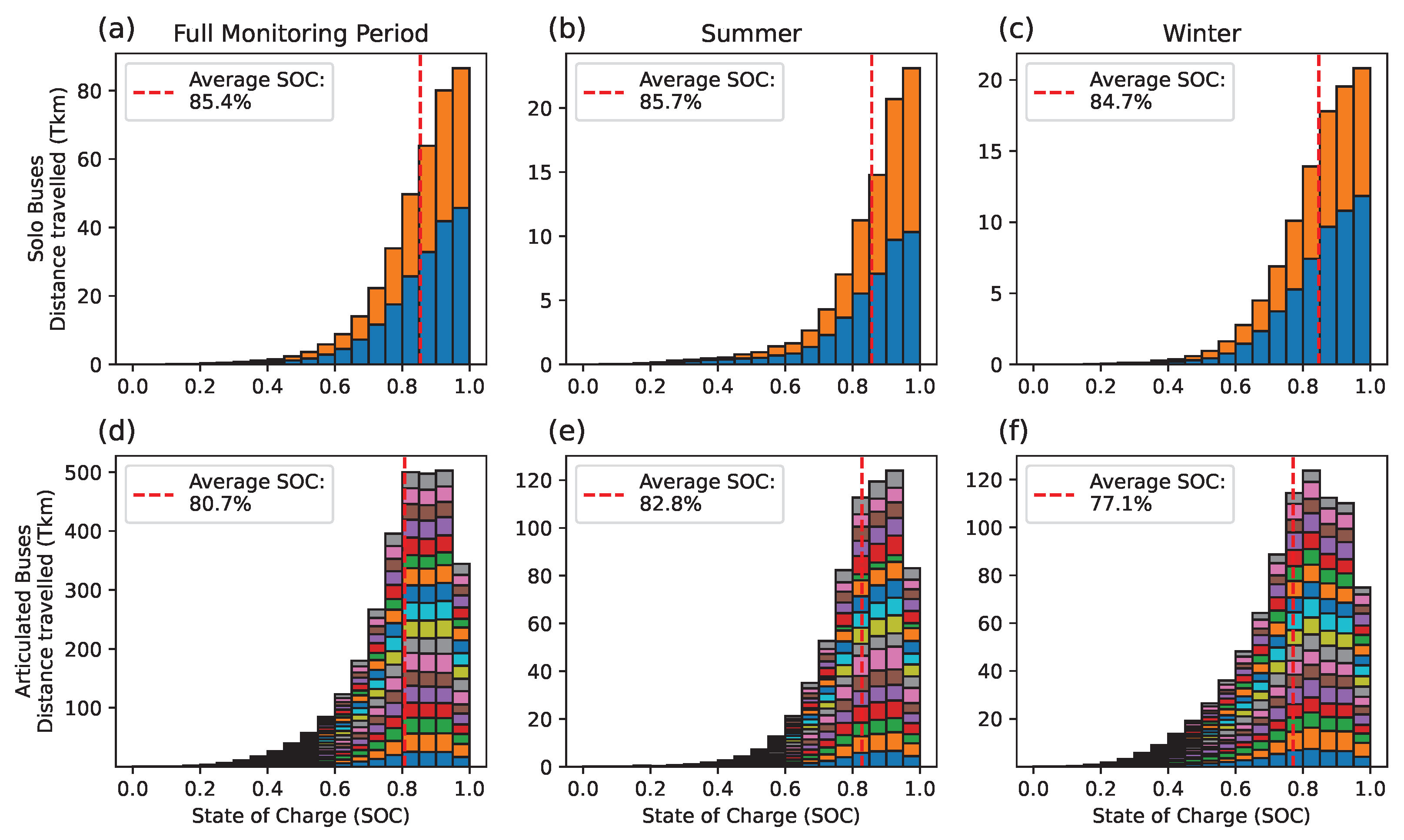
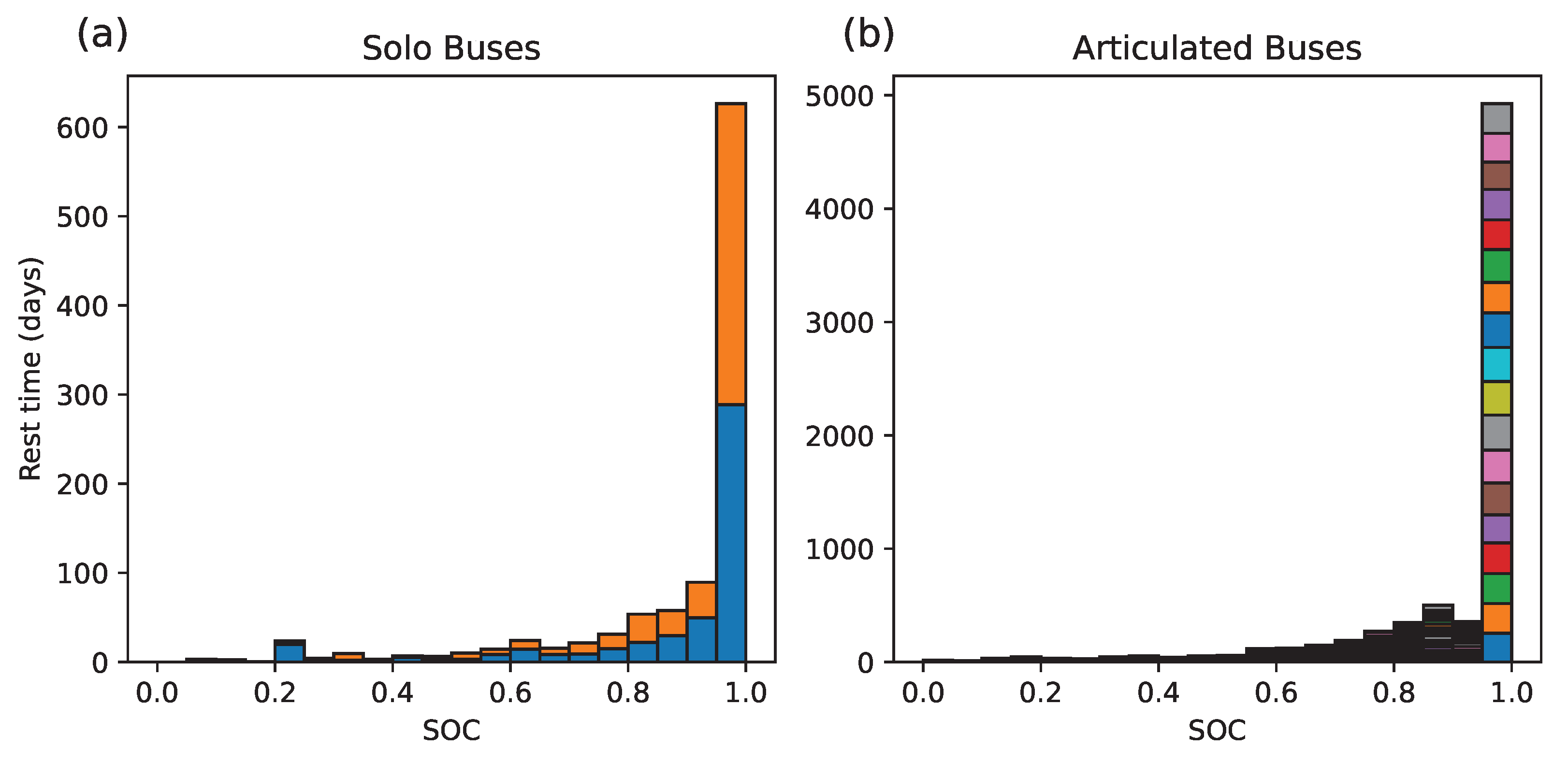
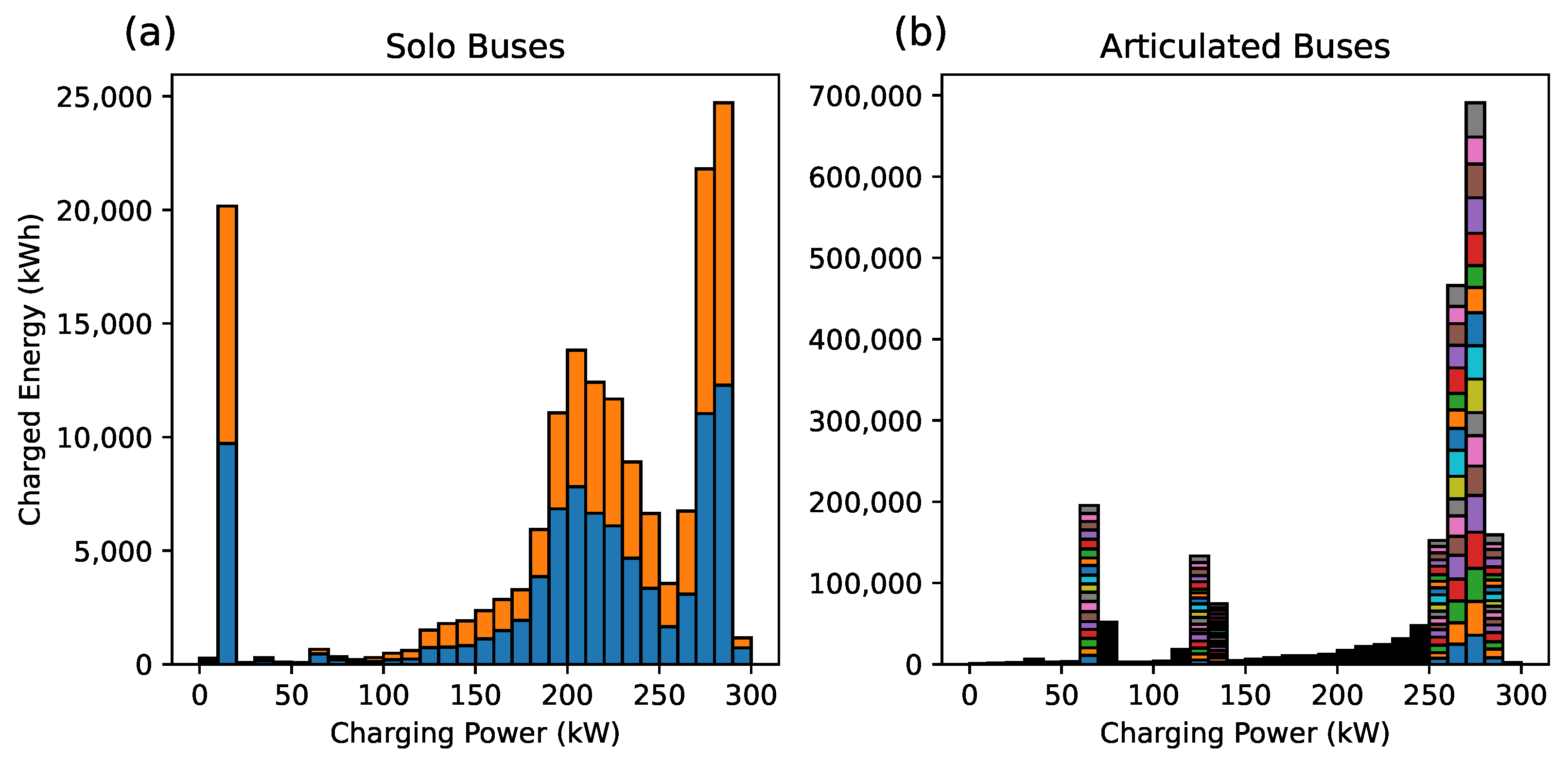
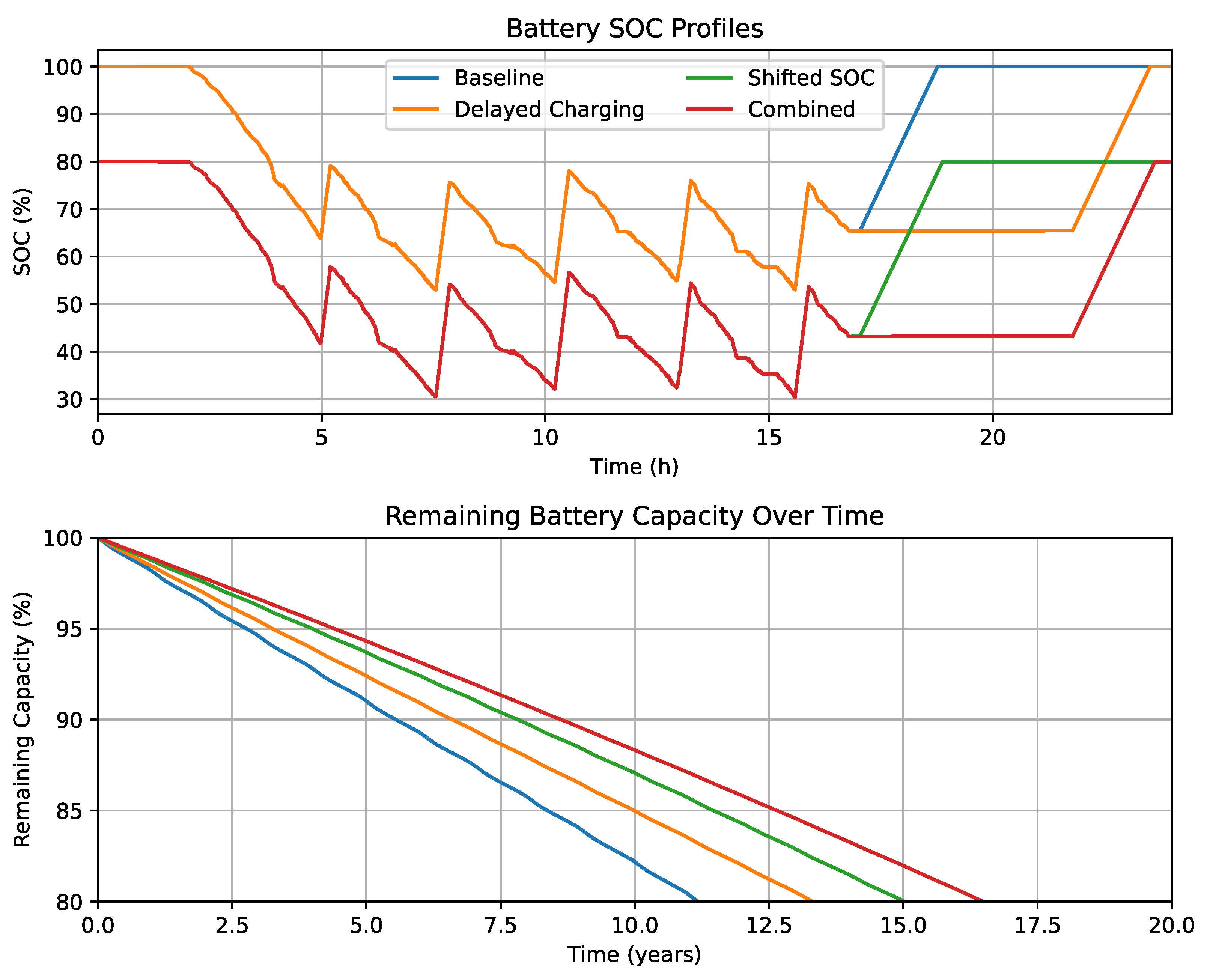
| Attribute | Solo Bus, 12 m | Articulated Bus, 18 m |
|---|---|---|
| Curb Weight including battery (t) | 14.5 | 21.9 |
| Engine Power (Peak/Continuous) (kW) | 250/125 | 250/125 |
| Total Battery Capacity (kWh) | 258 | 322.5 |
| Battery Chemistry | NMC | NMC |
| Total Monitored Distance (Tkm) | 372.6 | 3029.3 |
| Total Days in Monitoring | 2030 | 16,033 |
| Total Operating Days | 1413 | 11,564 |
| Signal | Unit | Time Resolution |
|---|---|---|
| Battery Power | kW | 100 ms |
| Battery Current | A | 100 ms |
| State of Charge (SOC) | % | On value-change |
| Vehicle Speed | km/h | 100 ms |
| Total mileage | km | 1 s |
| Vehicle weight | kg | 200 ms |
| GPS altitude | m | Few seconds (varying) |
| Ambient Temperature | °C | 1 h |
| Trip Nr. | Distance (km) | Energy (kWh) | Average Speed (km/h) | Ambient Temperature (°C) | Average Vehicle Weight (t) | Elevation Difference (m) | SEC (kWh/km) |
|---|---|---|---|---|---|---|---|
| 1 | 15.58 | 30.86 | 21.52 | 0.8 | 22.62 | 32.0 | 1.98 |
| 2 | 20.73 | 53.75 | 20.47 | 0.8 | 24.26 | 113.0 | 2.59 |
| 3 | 20.61 | 36.68 | 19.60 | 2.4 | 23.87 | −124.3 | 1.78 |
| 4 | 20.72 | 43.52 | 20.10 | 6.8 | 24.58 | 123.9 | 2.10 |
| 5 | 20.60 | 25.56 | 20.02 | 8.3 | 24.03 | −117.6 | 1.24 |
| 6 | 20.70 | 47.40 | 19.58 | 9.8 | 24.22 | 118.3 | 2.29 |
| 7 | 20.58 | 31.84 | 19.62 | 10.3 | 23.60 | −113.8 | 1.55 |
| 8 | 20.68 | 45.79 | 19.41 | 10.1 | 23.68 | 111.0 | 2.21 |
| 9 | 20.51 | 33.02 | 18.60 | 9.9 | 24.21 | −109.1 | 1.61 |
| 10 | 20.75 | 45.64 | 19.61 | 7.4 | 23.25 | 108.1 | 2.20 |
| 11 | 8.17 | 7.58 | 23.33 | 7.4 | 22.47 | −108.2 | 0.93 |
Disclaimer/Publisher’s Note: The statements, opinions and data contained in all publications are solely those of the individual author(s) and contributor(s) and not of MDPI and/or the editor(s). MDPI and/or the editor(s) disclaim responsibility for any injury to people or property resulting from any ideas, methods, instructions or products referred to in the content. |
© 2025 by the authors. Published by MDPI on behalf of the World Electric Vehicle Association. Licensee MDPI, Basel, Switzerland. This article is an open access article distributed under the terms and conditions of the Creative Commons Attribution (CC BY) license (https://creativecommons.org/licenses/by/4.0/).
Share and Cite
Klaproth, T.; Berendes, E.; Lehmann, T.; Kratzing, R.; Ufert, M. Empirical Energy Consumption Estimation and Battery Operation Analysis from Long-Term Monitoring of an Urban Electric Bus Fleet. World Electr. Veh. J. 2025, 16, 419. https://doi.org/10.3390/wevj16080419
Klaproth T, Berendes E, Lehmann T, Kratzing R, Ufert M. Empirical Energy Consumption Estimation and Battery Operation Analysis from Long-Term Monitoring of an Urban Electric Bus Fleet. World Electric Vehicle Journal. 2025; 16(8):419. https://doi.org/10.3390/wevj16080419
Chicago/Turabian StyleKlaproth, Tom, Erik Berendes, Thomas Lehmann, Richard Kratzing, and Martin Ufert. 2025. "Empirical Energy Consumption Estimation and Battery Operation Analysis from Long-Term Monitoring of an Urban Electric Bus Fleet" World Electric Vehicle Journal 16, no. 8: 419. https://doi.org/10.3390/wevj16080419
APA StyleKlaproth, T., Berendes, E., Lehmann, T., Kratzing, R., & Ufert, M. (2025). Empirical Energy Consumption Estimation and Battery Operation Analysis from Long-Term Monitoring of an Urban Electric Bus Fleet. World Electric Vehicle Journal, 16(8), 419. https://doi.org/10.3390/wevj16080419






